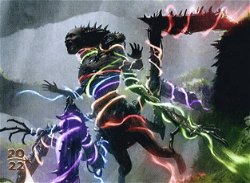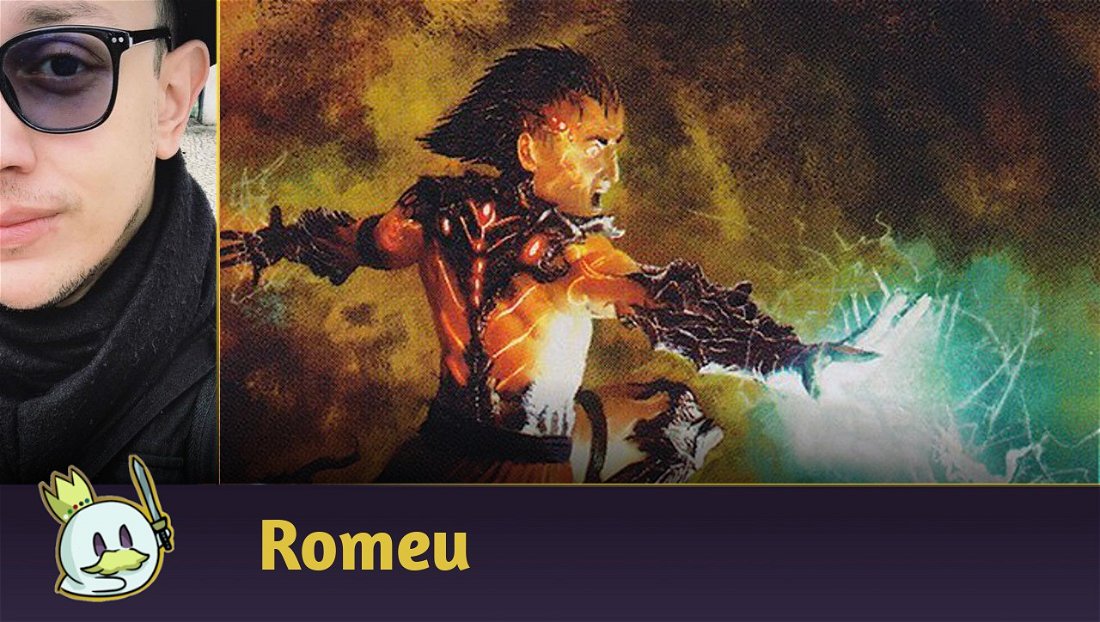As the Modern Metagame evolves, a strategy has gained more prominence in competitive events due to the combination between Leyline of the Guildpact and Scion of Draco - the Domain Zoo.
Being the first archetype to take advantage of the combo before it prevailed in Temur Rhinos, where it achieved a winrate of 60%, Zoo found in Leyline of the Guildpact the perfect piece to become the best aggressive deck in Modern.
Check out, in this article, the most recent version that I have been running in Magic Online leagues, along with a Sideboard guide for the main decks in the Modern Metagame!
What is Domain Zoo?
Zoo is the name of one of the oldest aggressive archetypes in Magic: The Gathering. It refers to a Naya (

Years later, in Modern, Zoo returned in several variants: Counter-Cat, which combined its efficient mana base with counterspells like Remand, and Shadow Zoo, which took advantage of Death's Shadow alongside of other powerful creatures to apply pressure and rely on the Temur Battle Rage combo. None of these variants became Tier 1 in the format.

With Modern Horizons II and Dominaria United, Zoo returned with a theme that fits well with its strategy: Domain. By already running cards that care about land types, adding a few more colors and making the most of Scion of Draco and Territorial Kavu is a minimal concession to have access to some of the best cards in the format today.
The inclusion of Leyline of the Guildpact in recent lists boosted its space in the Modern Metagame, where in addition to greatly facilitating access to mana of any color, allowing for a more aggressive first turn, the enchantment also makes Scion of Draco transform his creatures into almost unbeatable threats, demanding much more than just one-for-one trades.
The Decklist
This is my current Domain Zoo list.
Zoo has a very focused maindeck, but its sideboard is very divisive. For example, while I run Drannith Magistrate to deal with Cascade decks, other players can go for Chalice of the Void and there is no way to say which option is more appropriate without considering the presence of certain archetypes and /or how much proactivity is needed in these matchups.
Cards like Prismatic Ending, Tear Asunder, Path to Exile, Force of Vigor, Pick Your Poison and Legion's End fall into this same dilemma : The quality of each removal depends on what you expect to face and how much they matter in interactive games.
My Sideboard was built considering a very broad Metagame, where I want most cards to be usable in more than one specific game outside Cascade. Possible trades include Doorkeeper Thrull if Indomitable Creativity decks continue to grow, the inclusion of another Tear Asunder instead of Pick Your Poison if Scion of Draco + Leyline of the Guildpact lose space, or even Meddling Mage if the format becomes less interactive.
I highly recommend following this pattern for the 60 maindeck cards. This version is very consistent in most matchups and still maintains an attrition plan. It loses value if our opponent has a lot of removal, and we don't start the game with Scion of Draco and Leyline of the Guildpact, but this is a common price to pay when playing Aggro.
The sideboard, however, can be adapted as you prefer. No space in it is really written in stone, so consider the environment you intend to play in and update it accordingly - my guide can help you understand what matters and what doesn't for each matchup.
Maindeck

Zoo wouldn't be Zoo if it didn't use cheap creatures with high power.
Wild Nacatl is basically the face of this archetype. While its body is negligible due to the power creep and not generating any value, it remains one of the main aggressive drops available in Modern and interacts perfectly with our strategy.
Ragavan, Nimble Pilferer is one of the best creatures available in Modern and one of the best one-drops in the format. It generates value and carries games on its own if it isn't answered, and a removal against it means one less opponent's resource to deal with our larger creatures.
Territorial Kavu was the card that gave purpose to this deck. A 5/5 for two mana usually outgrows even Tarmogoyf in size in Modern, and offers hand filtering or graveyard hate in the maindeck whenever it attacks. It has excellent interaction with Inti, Seneschal of the Sun, but today we prefer to do broken things with Scion of Draco and Leyline of the Guildpact instead.
Nishoba Brawler is a more vulnerable version of Territorial Kavu, but adds consistency and redundancy to the threats we have in play. Unlike its predecessor, this creature tramples, so there are some advantages to having it in the list, despite it dying to Lightning Bolt.

The newest “combo” in the format.
Even without Leyline of the Guildpact, it is possible to cast Scion of Draco on the second turn with Domain Zoo by searching for Savai Triome on the first turn and Breeding Pool on the second. It offers significant advantages to your creatures if it stays in play, as well as being another evasive threat for a low cost.
With the enchantment in play, Scion of Draco can carry games on its own by hindering interactions while guaranteeing a keyword soup for your creatures, being extremely powerful alongside Territorial Kavu and Nishoba Brawler.

Zoo is an Aggro deck which uses red mana frequently. Therefore, Lightning Bolt is almost mandatory for your list as it offers ways to remove blockers to pressure the opponent, in addition to taking the last points of damage to them.
Another advantage in Domain Zoo is making the most out of Tribal Flames as removal, as well as being capable of winning games after a few attacks. It is common for players to make unfavorable trades to avoid being within its reach.
Leyline Binding occupies a space that, in the last decade, belonged to Path to Exile: a removal capable of dealing with any threat unconditionally while not offering a problem for our clock. Its value is enhanced by covering other permanent categories in addition to creatures, apart from the possibility of casting it very early or sequencing it with a creature.
Stubborn Denial is our default answer to spells and removals that we don't want resolved. As most of our creatures have four or more power, it is common for it to become a one-mana Negate. In the first few turns, using it as a Force Spike for key spells and/or targeted hate, like Blood Moon, are a common play.

Our Fetch Lands are selected for the purpose of searching for any of our Shocks and finding Savai Triome, or our basic lands in games where we need to respect Blood Moon and Magus of the Moon.
Even with Leyline of the Guildpact, it's important to look for at least one land with them to avoid taking a two-for-one from Pick Your Poison or another card if a Territorial Kavu is in game.

Our lands are selected with the aim of enabling Domain as early as possible, either with Savai Triome and Breeding Pool, or with a sequence of two Shock Lands and a basic land to close the cycle.

A land in each of the colors we need against Blood Moon is essential to maintain our strategy. It is common for us to choose to seek out a Forest to have access to our enchantment removals, such as Pick Your Poison and Tear Asunder.
Sideboard

Our “hosers”, cards that, in ideal situations, will delay the opponent until our creatures cause enough damage for our spells to end the game.
Drannith Magistrate is essential against Cascade decks, and alongside Scion of Draco and Leyline of the Guildpact, it can “lock” the game permanently.
Cursed Totem deals with Golgari Yawgmoth, but there are some games where we can use it to delay our opponent's turns.
Rest in Peace significantly delays Living End and blocks Golgari Yawgmoth's loops. You don't want too many copies of it, but you still need some amount of graveyard hate.

Prismatic Ending is our answer to Midranges and Aggro with low-cost threats, as well as resolving other problematic permanents like Amulet of Vigor.
Legion’s End is an efficient removal against Crashing Footfalls tokens, but we can also use it against Aggro or Midrange.
Path to Exile is our standard one-of answer against larger creatures like Murktide Regent or Primeval Titan
Tear Asunder is our instant-speed artifacts or enchantments removal, and doubles its functions if the game extends to the point where we really need to deal with another permanent for four mana.

Pick Your Poison has become a necessity for dealing with Scion of Draco or Leyline of the Guildpact, as well as responding to Blood Moon and other threats such as Murktide Regent, for just one mana.
Flusterstorm is a cheap answer against Cascade decks that the opponent cannot interact with without prolonging the game.
Sideboard Guide
Temur Rhinos
IN

OUT

Domain Rhinos
IN

OUT

Rakdos Evoke
IN

OUT

Golgari Yawgmoth
IN

OUT

Amulet Titan
IN

OUT

Izzet Murktide
IN

OUT

Living End
IN

OUT

Conclusion
That's all for today!
If you have any questions or suggestions, feel free to leave a comment.
Thanks for reading!
















— Comentários 0
, Reações 1
Seja o primeiro a comentar